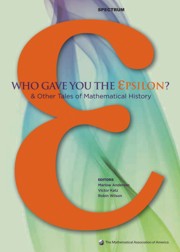Book contents
- Frontmatter
- Introduction
- Contents
- Analysis
- Geometry, Topology and Foundations
- Foreword
- Gauss and the Non-Euclidean Geometry
- History of the Parallel Postulate
- The Rise and Fall of Projective Geometry
- Notes on the History of Geometrical Ideas
- A note on the history of the Cantor set and Cantor function
- Evolution of the Topological Concept of “Connected”
- A Brief, Subjective History of Homology and Homotopy Theory in this Century
- The Origins of Modern Axiomatics: Pasch to Peano
- C. S. Peirce's Philosophy of Infinite Sets
- On the Development of Logics between the two World Wars
- Dedekind's Theorem:√2 × √3 = √6
- Afterword
- Algebra and Number Theory
- Surveys
- Index
- About the Editors
A note on the history of the Cantor set and Cantor function
from Geometry, Topology and Foundations
- Frontmatter
- Introduction
- Contents
- Analysis
- Geometry, Topology and Foundations
- Foreword
- Gauss and the Non-Euclidean Geometry
- History of the Parallel Postulate
- The Rise and Fall of Projective Geometry
- Notes on the History of Geometrical Ideas
- A note on the history of the Cantor set and Cantor function
- Evolution of the Topological Concept of “Connected”
- A Brief, Subjective History of Homology and Homotopy Theory in this Century
- The Origins of Modern Axiomatics: Pasch to Peano
- C. S. Peirce's Philosophy of Infinite Sets
- On the Development of Logics between the two World Wars
- Dedekind's Theorem:√2 × √3 = √6
- Afterword
- Algebra and Number Theory
- Surveys
- Index
- About the Editors
Summary
A search through the primary and secondary literature on Cantor yields little about the history of the Cantor set and Cantor function. In this note, we would like to give some of that history, a sketch of the ideas under consideration at the time of their discovery, and a hypothesis regarding how Cantor came upon them. In particular, Cantor was not the first to discover “Cantor sets”. Moreover, although the original discovery of Cantor sets had a decidedly geometric flavor, Cantor's discovery of the Cantor set and Cantor function was neither motivated by geometry nor did it involve geometry, even though this is how these objects are often introduced (see for example [24]). In fact, Cantor may have come upon them through a purely arithmetic program.
The systematic study of point set topology on the real line arose during the period 1870–1885 as mathematicians investigated two problems:
conditions under which a function could be integrated,
uniqueness of trigonometric series.
It was within the framework of these investigations that the two apparently independent discoveries of the Cantor set were made; each discovery was linked to one of these problems.
Bernhard Riemann (1826–1866) spent considerable time on the first question, and suggested conditions he thought might provide an answer. Although we will not discuss the two forms his conditions took ([16], pp. 17–18), we note that one of these conditions is important as it eventually led to the development of measure-theoretic integration (see [16], p. 28).
- Type
- Chapter
- Information
- Who Gave You the Epsilon?And Other Tales of Mathematical History, pp. 137 - 141Publisher: Mathematical Association of AmericaPrint publication year: 2009



